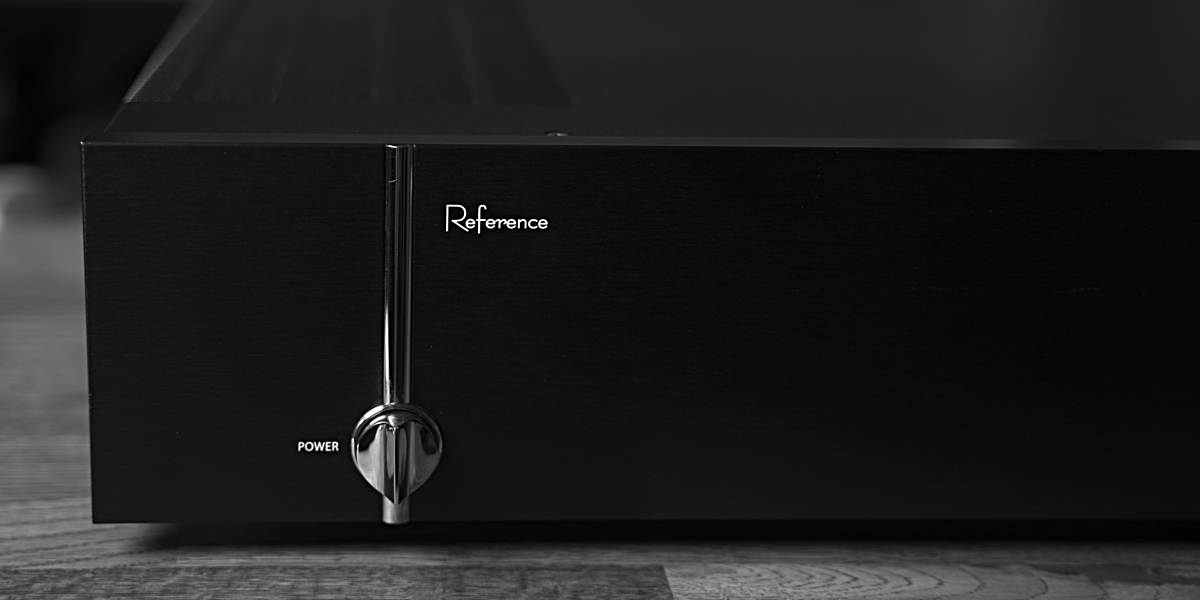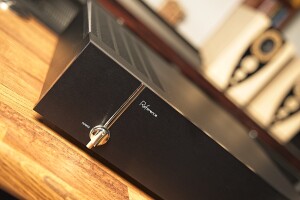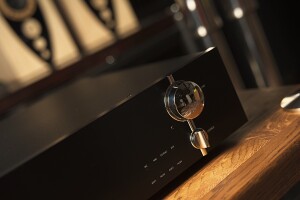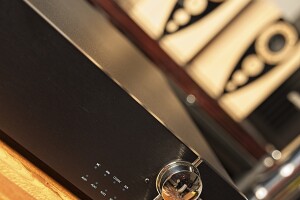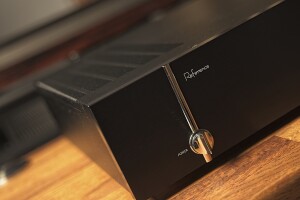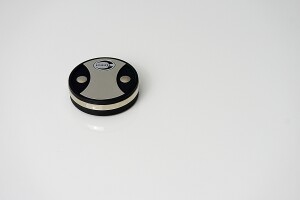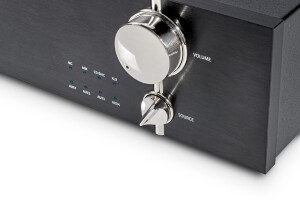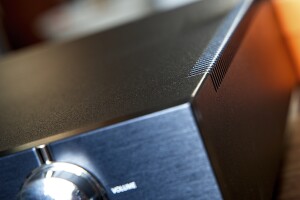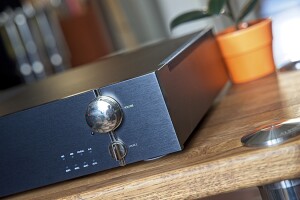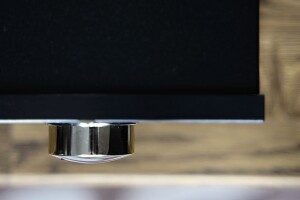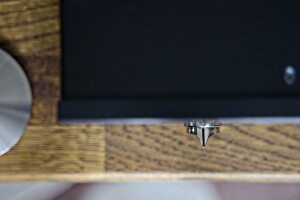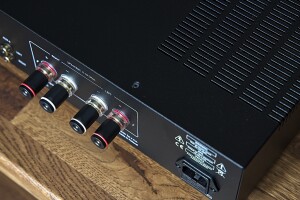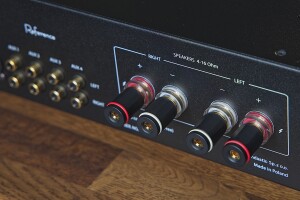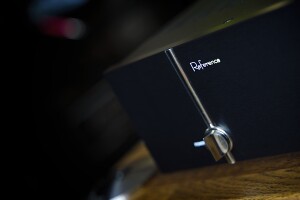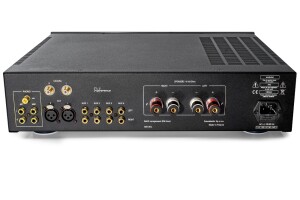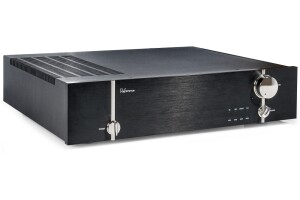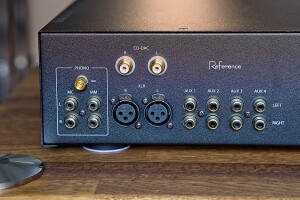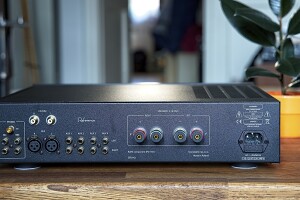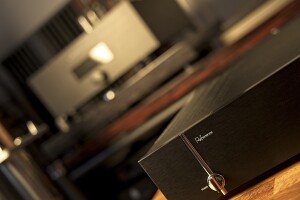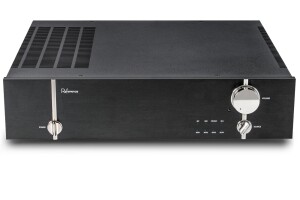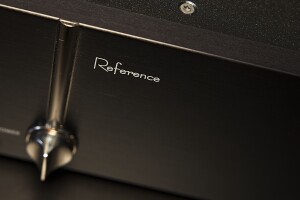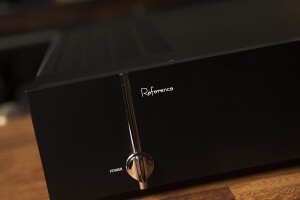Most of you may be (yet) unfamiliar with the brand Soundastic, but at the same time you probably know Struss Audio. The former is nothing else than the latter re-branded. Continuing the traditions of its predecessor, the new/old Polish manufacturer offers an integrated, the name of which suggests top performance from the start. Let me introduce you to the Soundastic Reference integrated amplifier.
Introduction
When the news about the passing of Mr. Struss, one of the most famous Polish amplifier designers with great knowledge and experience, arrived some time ago, it could have seemed that the days of the brand named after him were numbered. As it turned out, they were, but only because, according to the press release, the company’s shareholders decided to change its name to Soundastic. The current lineup of the new brand includes three integrated amplifiers – the DM-250, Ultimate, and the top of the range Reference.
It is the reviewed integrated amplifier named the Reference, which by itself seems significant, that is the first product offered under the new brand. Interestingly, on the outside, it is, first of all, still very similar to the DM250 I tested some time ago (see HERE), although the new design abandoned one interesting, at least from my point of view, element, namely the red wave theme on the front. On the other hand, the new Reference is almost identical to the Ultimate, which was introduced to the market after the DM250, still under the Struss Audio brand.
When looking at the fronts of both devices (ie Ultimate only in the pictures – I haven’t seen it live), it is difficult to point out any differences between them, apart from the model name and the logo of the previous brand (on the Ultimate). Interestingly, the Soundastic product has been completely devoid of the logo, and only the name is displayed on the front. The differences between the new model and the previous ones are more clearly visible on the rear panel. The Reference lacks the Pre-out and Power-in connectors, but instead, it offers phono inputs not only for MM but now also for MC cartridges and additional line inputs.
The device kept a compact, neat chassis measuring 430 x 95 x 358 mm and weighing 16 kg, which for quite a high output (2×140 W for 8Ω and 2 x 260W for 4Ω) device seems like not that much. By the way, the output figures are almost the same as for the DM-250. The Reference stroke me as being well-built and finished from the start. Although beauty is a relative thing, I believe that at least those who prefer elegance achieved with modest means will probably agree with me when I say that the designer of the amplifier’s housing managed to implement this idea nicely. All the fancy elements on the otherwise homogeneously black front are two shiny, silver vertical stripes and knobs. Let’s add to that maybe a bit too bright (for my taste, of course) blue LEDs indicating a selected input and the red one placed on the volume control knob to indicate its position and we get a complete picture of a modest, yet somehow elegant and eye-pleasing device.
Design and features
The Soundastic Reference is a solid-state integrated amplifier operating in the Class AB. This time, unlike for the DM250, I have not found confirmation whether the first several watts are output in Class A. I have already mentioned a solid build and finish quality. So let me add, that the front controls are limited to a medium-sized volume knob and two switches, one of which turns the device on and off, and the other is used to select an active input. Behind the first of them, also the largest one, one finds the well-known, motor-driven (which enables remote control), high quality, precise Blue Velvet Alps potentiometer. It plays a role of a passive preamplifier in the Reference model.
Users of the Reference will benefit from the large number of inputs it has to offer. The lack of the power-in and pre-out connectors present in both other models is here “made up” with additional line inputs, the number of sockets on the rear panel remains the same. So we have six inputs at our disposal, four of which are standard ones (with gold-plated sockets of the Japanese brand Jalco), and two are special ones marked as DAC/CD, with one featuring RCA sockets and the other one XLR (Amphenol). According to the manufacturer, this input has a smaller capacity than the others, which is supposed to guarantee a better quality of the reproduced sound. It may also turn out to be useful due to the larger spacing between the connectors, which will facilitate plugging in some larger plugs used in many high-class interconnects.
That’s not the end of what the Polish integrated has to offer. The Reference’s predecessors already offered a built-in phono stage supporting Moving Magnet (MM) cartridges. The new model goes a step further by offering two phono inputs, one for MM but the other for Moving Coil (MC) cartridges. The layout of the phono preamplifier module is based on discrete elements. According to the specification, the impedance of the MM input follows the 47kΩ standard, and the MC input is set at 100Ω. Users cannot change input impedance or gain for any of the phono inputs. The specification of the tested integrated places the sensitivity of the MC input at 0.2 mV, and of the MM at 3 mV. So it seems that they will work with a wide range of cartridges. The set of sockets on the rear panel is complemented by the IEC power inlet and solid speaker terminals. The manufacturer states in the manual that the Reference should be used with loudspeakers with an impedance of 4Ω, or more.
The Soundastic Reference is a dual-mono design. Its chassis is made of a non-magnetic alloy, which is to guarantee effective isolation from external interference. The front panel is made of an aluminum alloy used in the aviation industry. The power supply stage features two toroidal transformers of 500 VA each. According to the manufacturer, these transformers were chosen for a low level of losses, as well as high levels of inductance, smaller size, and very low magnetic dispersion field. They have been installed on anti-vibration bases and secured using a special epoxy mixture, while the fixing to the amplifier chassis has been carried out using a 3mm thick copper sheet. These solutions were chosen to eliminate the harmful influence of the presence of transformers on the MOSFET output transistors.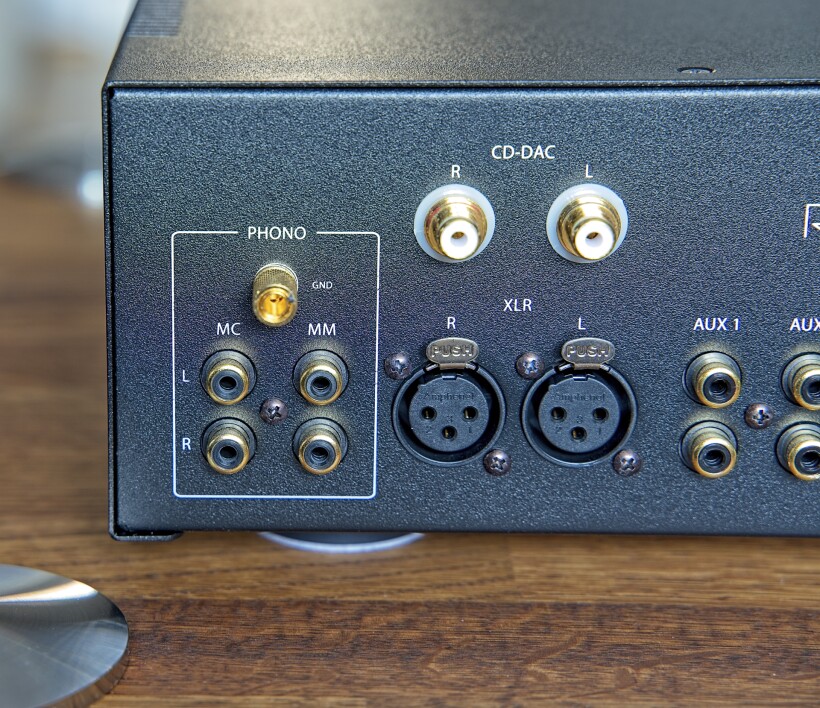
The latter were mounted on a 15 mm thick aluminum plate to eliminate possible residual vibrations caused by transformers. To be able to use a relatively small chassis, the designers developed a sufficiently effective convection cooling system that guarantees optimal working conditions for the electronic circuits of the amplifier. For the needs of the Reference, a new transformer delayed switching system (soft start), including an anti-interference filter, was also designed. This solution eliminates over-voltages when the amplifier is turned on and their detrimental effect on the lifetime of electrolytic capacitors.
The Reference’s output stage consists of two balanced power amplifiers powered by Nippon ChemiCon electrolytic capacitors with a total capacity of 48,000 μF. The design of the power amplifiers is based on Soundastic’s patent (RP No. 176514). There are no capacitors in the signal path of the amplifiers, as designers used only JFET transistors in a symmetrical arrangement. As the output transistors manufacturer used two pairs of American MOSFETs from International Rectifier per channel (8 pcs in total). The amplifier was also equipped with a protection system against its damage, e.g. in the event of a temporary short circuit of the speaker outputs/cables and protection of the loudspeakers in the event of a DC voltage in the amp’s outputs. The device is delivered with an original, round, aluminum remote control, that we know already from the DM250. It allows users to adjust volume, it weighs an impressive 0.37 kg, and features a rechargeable battery (there is a USB port for charging). Let me add that, which is not so common, the device is delivered with a clear and detailed instruction manual in Polish, but also in English, German and French.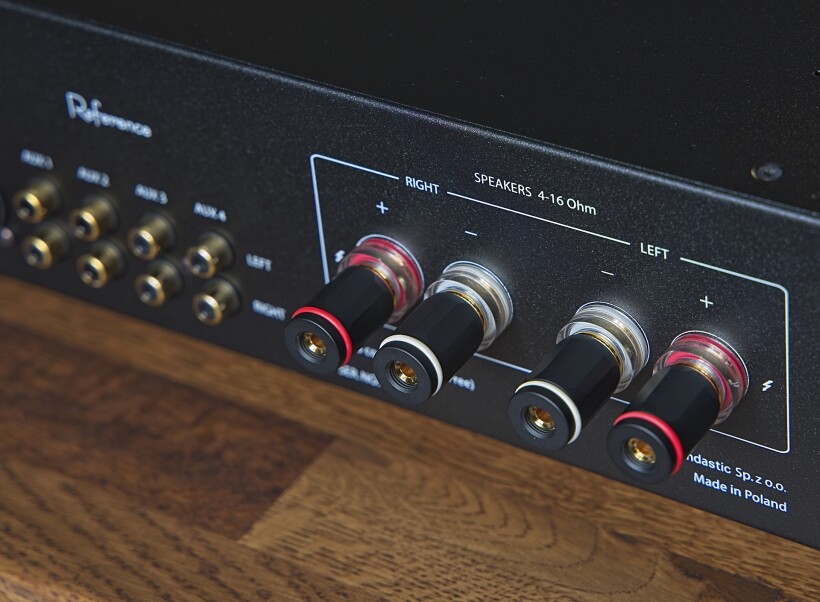
Sound
The first listening sessions of the Reference were supposed to be casual, so to speak. I connected the amplifier to the Ubiq Model One Duelund Edition and fed it with the signal coming from my reference D/A Converter, the LampizatOr Pacific. The idea was to give the Polish integrated time to accommodate in the system while I was taking care of other business, writing, translating, and so on. But the Soundastic Reference had its own plans. It didn’t just want to play in the background, even though the volume level was set quite low. It was not going to tolerate being ignored. The long playlist I prepared in Roon contained many various albums that the system played one after the other. For example, an album of the fantastic trombonist from New Orleans, Trombone Shorty (or Troy Michael Andrews). His lively, incredibly energetic style of playing is easily recognizable and it was no different this time.
The Reference (let me emphasize once again that I kept a relatively low volume level setting intended for “background music”, not „listening to the music”) beautifully presented all those features of Trombone Shorty’s performance. All my limbs involuntarily tapped out those live rhythms, the head kept rocking, and my focus gradually shifted from the work in front of me to the natural, true timbre and texture of the master’s trombone, as well as of the other accompanying instruments, with the brass ones in particular. 
The sound was pure, clear, but not bright – any actual brightening of the sound would have been immediately clear with brass instruments because their naturally sharp sound would have become unpleasant and it did not. Instead, it was presented as juicy, strong, with the breath, with great pace and rhythm – in a word, I was served a great fun I associate the New Orleans music with. So I had no choice – I gave up the work and pumped up the volume. It did not make any impression on the tested integrated – the sound was still exceptionally clean, as in without any hint of distortion or coloration, and at the same time quite dense (though not as much as with my, twice as expensive, Italian Class A Shinai), well-organized, and transparent. Each element of the complex performance had its well-defined place in the mix and 3D space on the soundstage, confirming the excellent control the Reference exerted over the speakers. The whole presentation seemed effortless, yet it had a proper momentum, and the sound was powerful as the brass instruments were recorded from up close, and there was also that unique joy of playing music, having fun with it, characteristic for Trombone Shorty.
The next album on the list also kept me from getting back to work. It was not even the famous soundtrack from the first „Blade Runner”, but an additional disc from a special anniversary version of it, with previously unreleased and bonus recordings. This was an intentional, supposedly “smart” move on my side to choose it for the playlist, as initially I planned to avoid involvement in music, and focus on the work at hand (which the original soundtrack would have surely prevented, as I love the film and the soundtrack). My clever plan failed miserably, as also this time the Soundastic Reference pulled me by the ears into the extraordinary world created by Vangelis.
The Polish, all-solid-state amplifier surprised me this time with the huge space it rendered and its openness, in which all the familiar and less familiar sounds and motifs were placed. Although these were not pieces taken directly from the film, and thus recalling specific scenes, I still „saw” the original world of Blade Runner presented in front of my eyes. It was properly dark, raw, rainy, sometimes even depressing (as a vision of the near future, at least at the time the movie came out), but also fascinating, unique, one of a kind. The Reference was able to perfectly build the unique atmosphere of this world, to convey, with the help of just the sound, probably as many emotions as the combination of the image with the soundtrack during the film screening, and thus draw me completely in from the first to the very last sound.
Actually, at this point, I should have skipped trying to use Reference to play music just in the background, but I made one more attempt to get back to work. However, when the excellent recording of the Rimsky-Korsakov’s “Capriccio Espagnol” (Spanish Caprices) began, once again and for the last time, I was pulled away from my laptop’s screen, firstly to (significantly) increase the volume level and secondly to „look” at the huge sound panorama. The sound of the orchestra exceeded the spacing of the loudspeakers (which is not as easy with the Ubiqs in my room as with my other pair, GrandiNote MACH4), but it also surprised (although at this stage of listening/not listening it probably should have not surprised me anymore) with its multi-layered depth. Before I had a chance to take a closer look at the latter, the orchestra took off for good, showing the momentum, scale, and power of sound, which, of course, cannot be reproduced at home in a 1:1 scale, but played by the Soundastic Reference integrated, each of these elements was delivered in a truly impressive way.
The tested amplifier kept a tight grip on my larger (and more difficult to drive) loudspeakers with closed cabinets, making sure that the presentation was well-organized and arranged and fully controlled even in the densest, hottest, most dynamic fragments. The sound, although so disciplined and focused, was at the same time effortless, fluid, coherent, and, which was very important, also natural. The latter feature resulted from better saturation of sounds (compared to the DM-250), which stemmed largely from better resolution and blacker background.
I was unable to point out any shortcomings in terms of differentiation, the separation was also very good, so it was easy to follow any chosen element of the recording, whether it was a soloist or specific groups of instruments. As a result, Rimsky-Korsakov’s composition was so enjoyable, that I immediately supplemented the Roon’s playlist with several new albums with classical music. While playing them, the Reference each time presented a similar set of features – first of all, the very good control over the loudspeakers, thanks to which it was able to play Mahler, Beethoven, or Mozart in this beautifully effortless, dynamic way, offering a resolving, rich with tiny information, coherent, well-differentiated sound that I enjoyed so much, that I just craved for more and more of this genre.
Kinga Głyk’s album “Dream” directed my attention towards the bass range, I mean the deepest end of it really, as the Soundastic Reference was able to bring out from my Ubiqs truly low, weighted, energetic, but also tightly controlled sounds of the artist’s electric bass. The pace and rhythm were great, which should not have surprised me anymore after the experience so far. As the subsequent albums with this instrument showed, for example with Marcus Miller or Stanley Clarke, the Soundastic Reference had a lot to say in terms of conveying very natural timbre and texture, but also individual styles of each of the masters of an electric bass. 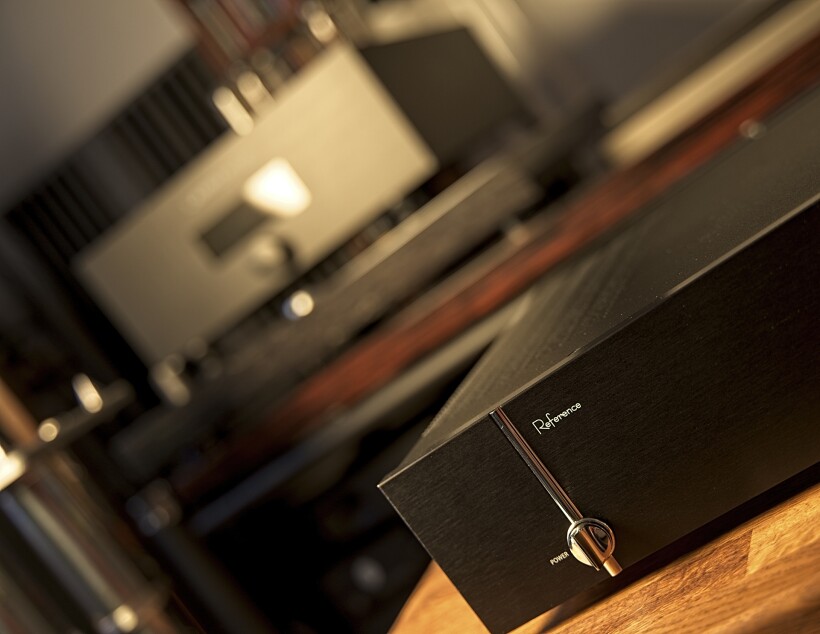
Such good differentiation made each of these albums, even those known to me by heart, played by the Soundastic integrated, interesting, or even (for a true acoustic and electric bass enthusiast) exciting. I would say that the electric bass with the Reference was even slightly more convincing than with my Shinai, although I preferred the latter when it came to the acoustic bass. The thing was in a better control ensured by the Soundastic amplifier, which translated into a faster attack but also immediately stopping the sound (when needed). On the other hand, the advantage of the GrandiNote’s amp was clear in better portrayal of sustain and decay phases of the sounds and even better tonal saturation, which favored its presentation of any acoustic bass.
“A story of Polish jazz” by Jarek Śmietana, played from an excellent AC Records vinyl, proved the class and sophistication of the tested integrated amplifier. The Soundastic Reference in the opening jazz-rap piece effortlessly kept up with the pace imposed by the musicians, led the rhythm perfectly, and at the same time with the appropriate care, in a real, expressive way, it presented the vocals in a rap-style “conversation”. The album is unique because, as the title suggests, a whole galaxy of Polish jazz masters participated in this project. The top Soundastic amplifier proved that it was not only a refined, but also versatile device, capable of conveying equally realistically both, Jarek’s guitar and Stanko’s trumpet, Muniak’s saxophone, and Urbaniak’s violin, Adam Czerwiński’s drums, or Karolak’s Hammonds (to mention only some of the exceptional musicians appearing on this one album).
The Soundastic provided me with an open, consistent, smooth performance, with good insight into the deeper layers of the music, with easy access to details and subtleties that caught my attention, with seamless tracking of the selected musician. As this is a high-quality release, the tested amplifier had an opportunity to prove itself and used it to the full extent. The cymbals were crisp, vibrant, energetic, just as the drums on the other edge of the band – fast, tight, with a well-defined, hard, fast attack and going down as low as the recording required them to. My Shinai sounds a bit denser, a bit warmer, and also has a certain, though not so big, an advantage in terms of resolution, but it’s worth remembering, that it is also circa twice as expensive. While focusing on listening to the music with the Reference, I did not feel any shortcomings, I didn’t miss anything compared to the sound I was used to. It did deliver excellent performance, which I truly enjoyed, which is not the case that often with pure solid-state amplifiers.
Summary
Although more than two years have passed since the DM-250 test, which makes it a bit difficult to compare it with the Soundastic Reference, I do not have any doubts that the new integrated amplifier is a more refined, better-sounding, even higher class device. The simplest description of the basic difference between these two that feels right to me is … a higher culture of presentation offered by the new, top integrated. The point is not that the DM-250 was missing something in this regard, not at all. The Reference simply delivers better, denser, more refined, and more essential performance, so to speak.
The new Soundastic also offers a slightly better resolution and differentiation, and this characteristic feature of the DM-250, its exuberant temperament, has been tamed a bit (hence more refined). The superiority of the tested integrated and talents of its designers are best evidenced by the fact that the latter difference is not manifested in any decrease of the dynamics or energetic abilities of the Reference, but in a better grip exerted over speakers, and this relaxed, highly sophisticated way of playing music, which results in a fuller, richer, and better differentiated, ergo more complete presentation.
The treble with the tested integrated seems more refined. It is more open, vibrant, full of energy, perfectly differentiated, but also smoother, or simply put, shown in an even more realistic, natural way. Also, the midrange seems more saturated, more colorful, although not as much as in the case of another excellent Polish product – the Circle Labs A200 (see HERE), or my Italian GrandiNote Shinai. I guess it’s the bass, its momentum, tight control, differentiation, speed, texture, and timbre, that resemble most what I remember from the DM-250 audition, although also here, I believe, the Reference’s potential is even greater, because the bass goes even lower, and it is more saturated.
Technical specifications (according to the manufacturer):
- Output: 2 x 140 W / 8 Ω; 2 x 260 W / 4 Ω
- Frequency range: 5Hz – 100 kHz 3 dB / 1 W / 8Ω; 10 – 30 000 Hz / ± 0.01 dB
- THD: 0.05% @ 1 W / 8 Ω; 0.02% @ 120 W / 8 Ω
- Slew rate: 150 V/μs
- S/N: 130 dB (IHF – A)
- Input sensitivity: 500 mV (RCA), 500 mV (XLR), 3 mV (MM Phono), 0,2 mV (MC Phono)
- Input impedance: 100 kΩ RCA), XLR: 22 kΩ (XLR), 47 kΩ (MM Phono), 100 Ω (MC Phono)
- Power consumption: 40 VA – 1200 VA (peak)
- Potentiometer (volume): Alps Blue Velvet
- Transformers: 2 x toroidal, 500 VA each
- Capacitors filtering supply voltage: 4 x 15 000 μF – Nippon Chemi-Con
- Dimensions (W x H x D): 430 x 95 x 358 mm
- Weight: 16 kg
Price (when reviewed):
- Soundastic Reference: 6.500 EUR
Manufacturer: Soundastic
Associated equipment:
- Digital source: a custom passive server with WIN10, Roon, Fidelizer Pro 7.10, JCAT NET XE and JCAT USB XE cards with FERRUM HYPSOS Signature power supply, KECES P8 (mono) linear power supply for the server, JCAT USB Isolator
- D/A Converter: LampizatOr Pacific +Ideon Audio 3R Master Time (USB signal regenerator)
- Analogue front end: J.Sikora Standard MAX turntable, J.Sikora KV12 tonearm, AirTight PC-3, phonostages: Grandinote Celio mk IV, ESE Lab Nibiru V 5.
- Power amplifiers: GrandiNote Shinai
- Preamplifier: Audia Flight FLS1
- Loudspeakers: GrandiNote MACH4, Ubiq Audio Model ONE Duelund Edition.
- Interconnects: Hijiri Million, Hijiri HCI-20, TelluriumQ Ultra Black, KBL Sound Zodiac XLR, David Laboga Expression Emerald USB, David Laboga Digital Sound Wave Sapphire Ethernet
- Speaker cables: LessLoss Anchorwave
- Power cables: LessLoss DFPC Signature, Gigawatt LC-3
- Power: Gigawatt PF-2 MK2 and Gigawatt PC-3 SE Evo+; a custom power line with Gigawatt LC-Y in-wall cable; Gigawatt G-044 Schuko and Furutech FT-SWS-D (R)
- Network: Silent Angel Bonn N8 + Silent Angel Forester F1 + optical LAN isolator
- Racks: Base VI, Rogoz Audio 3RP3/BBS
- Anti-vibration accessories: ROGOZ-AUDIO SMO40 and CPPB16 platforms and ROGOZ AUDIO BW40MKII feet, Franc Accessories Ceramic Disc Slim Feet and Wood Block Platform


